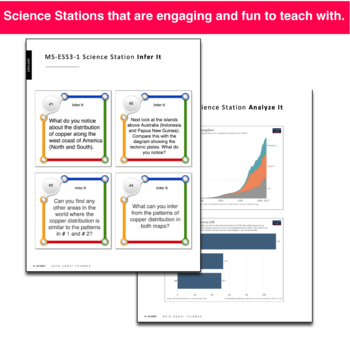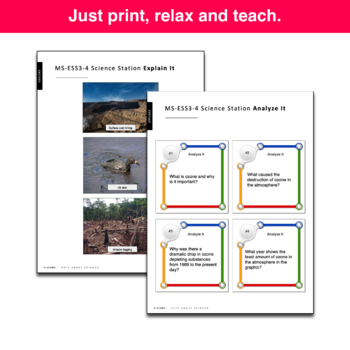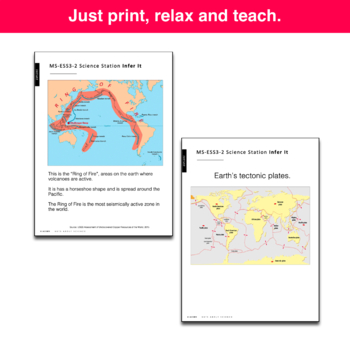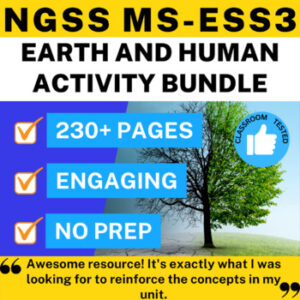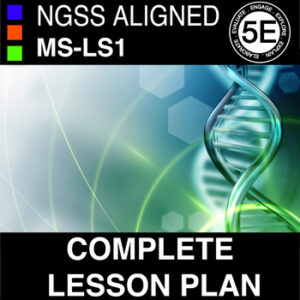Description
Your students will love learning about the Earth and Human Activity with these engaging activities. Easy to follow and fun to use and teach. These science stations are specially designed to align with all the standards in the NGSS unit MSESS3 Earth and Human Activity.
“This was an amazing resource for my 8th graders. I broke it up into multiple days and we discussed as we went. I am so glad I found this resource!” Amy S.
“Awesome resource! It’s exactly what I was looking for to reinforce the concepts in my unit and worked great for an interactive distance activity. Thank you so much!” Bio4Life
A google classroom distance learning version is also included so you’re all set whether you have face to face classes or have to teach remotely. You can relax and teach knowing that you’ve got this covered.
MS-ESS3-1 Uneven Distribution of Resources
- Uneven distribution of coal, copper, groundwater, natural and shale gas
- That the uneven distributions of the Earth’s mineral, energy, and groundwater resources are the results of past and current geologic processes.
- Type and distribution of a: mineral, energy, and groundwater.
- Evidence for the past and current geologic processes (e.g., volcanic activity, sedimentary processes) that have resulted in the formation of each of the given resources.
- The ways in which the extraction of each type of resource by humans changes how much and where more of that resource can be found.
MS-ESS3-2 Natural Hazards
- What is a natural hazard
- Types of natural hazard
- Predicting a natural hazard
- Understanding the natural hazards in a region and their causes
- Human and economic cost of natural hazards
MS-ESS3-3 Minimize Human Impact on the Environment
- Deforestation
- The Downside of Dams
- Diverting Rivers
- Land Desertification
- Air Pollution
MS-ESS3-4 Human Impact on the Environment
- Tech It – Students will view an interactive map on a human impact on the environment and answer questions.
- Graph It – students will create a graph from a set of data allowing them to compare the effects of human population increase with an environmental impact.
- Read It – here the students read about the impact of plastic pollution.
- Label It – students will create an infographic based on the provided text and data.
- Explain It – students are shown photos of human impacts on the environment and they are asked to explain these.
- Analyze It – students are given information on how positive changes at a global level have made an impact on the environment. The questions on the station sheet will ask them to analyze these diagrams.
MS-ESS3-5 Human Impact on Global Temperatures
Lawyer up and prepare your defense ✍! Global warming is in the dock. Time to bring in the expert witnesses. Your students are going to examine the evidence that it is human activity that has caused global warming and prepare a defense.
- Exhibit A: CO2 levels Students will read about the increase and causes of CO2 levels and then answer questions in their defense pack
- Exhibit B: Global Temperature Rise Students will look at the trend in global temperatures and use this as part of their defense
- Exhibit C: Cement Production Students will visit a website and look at the impact of cement production on CO2 levels.
- Exhibit D: Agriculture Students will create an infographic on supplied data detailing the greenhouse gas emission in agriculture.
- Exhibit E Effect of Volcanoes This evidence can be used to counter any argument that volcanoes have a greater impact in CO2 emissions than humans.
- Exhibit F The Sun’s Role
Students will read evidence to show that the sun cannot be responsible for an increase in global temperature.
NGSS and Next Generation Science Standards are a registered trademark of Achieve. Neither Achieve nor the lead states and partners that developed the Next Generation Science Standards was involved in the production of, and does not endorse, this product.


